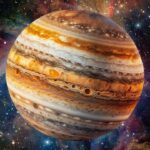
📷 Image Credits: Mint
The mysterious world of space has always captivated the curiosity of humans, with its unexplained mysteries serving as a continuous quest for scientific exploration. To bring the wonders of space closer to the public, NASA, the National Aeronautics of Space Administration, consistently shares breathtaking images of celestial bodies and galaxies. Here, we delve into the top 5 images captured and shared by NASA, showcasing the marvels of the cosmos.
In one of the images shared by NASA, we witness the giant planet, Jupiter, crowned with stunning Aurora lights, captured by the NASA Hubble Space Telescope in infrared light. The mesmerizing image gives us a glimpse of the beauty and dynamism of the gas giant. Auroras, such as the ones seen on Jupiter, are formed when high-energy particles interact with a planet’s atmosphere near the magnetic poles, creating a spectacular display of light.
Moving further into the depths of space, NASA’s Hubble Space Telescope captured an image of the Carina Nebula, a dynamic star formation region located approximately 7,600 light-years away. Described as a ‘star factory,’ the Carina Nebula showcases the intricate process of stellar birth, as dust and gases collapse under gravity to form new stars, illuminating the cosmic landscape.
Another captivating image shared by NASA features a cloud of gas and dust filled with bubbles, each housing hundreds to thousands of young, massive stars. These bubbles, inflated by dense clouds of gas and dust, offer a remarkable insight into the intricate ecosystem of star formation within our vast universe.
Additionally, NASA’s visuals take us to NGC 604, a star-forming region hosting over 200 of the hottest and most massive stars. This unique region, unlike any other within our Milky Way galaxy, provides astronomers with a window to study young, massive stars and gain valuable insights into the complexities of stellar evolution.
Furthermore, NASA’s imagery introduces us to the Herbig-Haro 46/47, a tightly bound pair of actively forming stars, unveiling unseen corners of the universe. The detailed images, made possible by NASA’s sophisticated telescopes and advanced technology, offer a glimpse into the fascinating process of star formation and evolution in space.
The universe, with its vast expanse and endless wonders, continues to captivate our hearts and minds, inviting us to explore the mysteries and beauty of space. Through the lens of NASA’s high-resolution telescopes and groundbreaking technology, we are granted a front-row seat to the remarkable spectacle of star factories, nebulae, and cosmic phenomena, igniting our curiosity and expanding our understanding of the cosmos.







